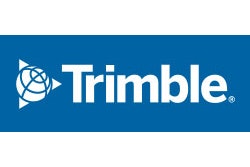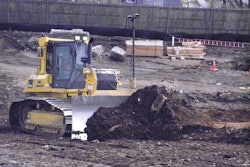
The Challenge:
Stake and place over 173,000 pylons with minimal disturbance to the surrounding environment
The Players:
Bechtel
Trimble
Hercules Machinery Company
The Process:
The BrightSource Energy-designed Ivanpah Solar Electric Generating System (ISEGS) in California’s Mojave Desert is a 392 megawatt gross solar complex using more than 300,000 garage-door-size mirrors to focus the power of the sun on solar receivers atop power towers. It is currently the largest concentrated solar plant under construction in the world.
The project is located about five miles from the California-Nevada border on federal land managed by the Bureau of Land Management. When completed ISEGS will provide much needed power during the peak hours of the day to more than 140,000 homes in California.
The ISEGS complex is comprised of three separate plants being built in phases between 2010 and 2013. San Francisco-based Bechtel, an engineering, construction and procurement firm, is responsible for managing the construction process of the unique project. It has more than 2,000 employees working on the site.
“I had worked with grade control technology in the past and felt comfortable soliciting input early in the process to see if there might be an efficient GPS machine control solution for building the solar fields,” states Mark Wagner, lead area superintendent with Bechtel. “We were looking at the precision placement of 173,500 pylons scattered over 3,600 acres, so traditional staking would be incredibly time consuming and very costly.”
It was clear that the ISEGS project would be more than a typical machine control system project, so Dave George, commercial manager-worldwide with Trimble brought in the local Trimble dealer and appropriate product and machine experts from within Trimble, including personnel from the U.S., New Zealand and Holland. The project would require a highly customized solution.
The three parties - Bechtel, Trimble, and the local Trimble dealer - determined that an excavator-mounted vibratory hammer could work if the Trimble technology and custom attachment could work together. They travelled to vibratory hammer manufacturer, Hercules Machinery Company (HMC), headquarters in Fort Wayne, Ind., to create a custom vibratory hammer that could be mounted to a long reach excavator, with the ability to traverse the ephemeral washes of the site and still meet the tight tolerances required for the pylon insertion.
“We were looking at 173,500 holes that needed to be drilled and 173,500 pylons that needed to be inserted,” Wagner says. “The rigs had to have the accuracy of a surveyor’s rod and the ability to collect the pylon’s ‘as-built’ data.” The answer came from Trimble, who had experience with Trimble HYDROpro Construction Software, a software package for specialized waterway and coastal construction tasks that require precise point positioning.
HYDROpro Construction’s pile feature is used for precise pile positioning applications for bridge and wharf construction. Trimble engineers were able to modify this powerful construction software for use on the Mojave Desert site where water is scarce, and the average annual rainfall is less than five inches.
Three different rounds of testing occurred before adopting the custom approach for implementation. BrightSource has stringent requirements for its outcome and how the project would be completed.
Minimizing environmental impact
Because of environmental impact concerns regarding disruption of soil, plant and animal life, the site was not graded before the pylons were placed. The site’s three solar fields have alternating bands of “drive zones” and “no-drive zones.” The excavators are allowed to maneuver and operate in the 130-foot wide no-drive zones due to their innovative design.
The excavators are equipped with custom, shortened masts manufactured by HMC, so that they can safely reach multiple pylons from one location within the no-drive zones. The excavators have wide tracks with triple grousers for low impact. Their long reach and multiple degrees of freedom of the mast mean that they don’t have to drive up to each pylon like a traditional pile-driving rig would need to do. Since the drill and the vibratory hammer are interchangeable on the mast, the same make and model excavators are used for both drilling and insertion. That means they travel in the same tracks with each pass through the solar field, reducing impact to the desert even further.
The role of HYDROpro
The BrightSource Ivanpah Solar Electric Generating System has 14 excavators working on the site, and all are equipped with Trimble HYDROpro Systems. The Bechtel crews are averaging between 75 and 125 pylons per day, per machine.
The Trimble HYDROpro Construction system is used strictly for its positioning and data collection capabilities - which saved Bechtel approximately 10 to 30-minutes of surveyor time per pylon - to lay out the holes, lay out the pylons and collect the as-built data after the pylon was inserted.
“Our excavators with the HYDROpro systems provide precise XY location as well as verticality and orientation,” Wagner says. “Trimble also helped us collect Z (sea level) elevation of the top of the pylon, which is fed into and collected by HYDROpro.”
Each excavator cab is outfitted with a Trimble Tablet handheld computer running HYDROpro System software. The machines have two receivers - a Trimble SPS852 GNSS Modular Site Positioning System Receiver and a Trimble SPS552H Heading Add-on GNSS Receiver, which is designed to calculate the precise heading of the machine so that all the pylons can be oriented per specification.
Additionally, the Trimble system was instrumental because BrightSource required GPS for converting the latitude and longitude into an ECEF or Earth Center, Earth Fixed location. BrightSource uses a center of earth location in relation to the sun so that each mirror in its solar generating system is precisely aligned.



















